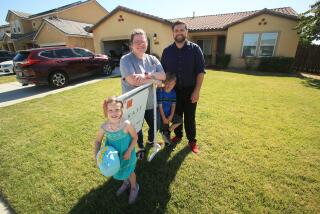Rust Belt Seeing Its Luster of the ‘90s Start to Fade
- Share via
FORT WAYNE, Ind. — Beau Maggart used to make axles, but last week he was seated at a computer screen typing his resume into a databank. Laid off a month ago from Dana Corp.’s axle plant here, he had been making as much as $80,000 a year, thanks to copious overtime. After a failed job search, he came to this “transition center” set up by his union to help former employees find work.
Maggart, a 37-year-old husband and father of two, is one of the early victims of a downturn in the automotive industry that is liable to be ground zero for any recession that grows out of the nation’s unexpectedly abrupt economic slowdown.
He and 800 co-workers have been issued pink slips by Dana, one of the country’s largest automotive parts suppliers. The troubles at Dana reflect the Midwest in general: When the auto industry catches a cold, the Michigan-Indiana-Ohio region, teeming with auto factories and parts suppliers, catches pneumonia.
It’s an area that once was called the Rust Belt for its deteriorating, vacant factories, but in the 1990s it enjoyed enormous prosperity as Americans bought more cars and trucks than ever before. Indeed, the Fort Wayne unemployment rate, though edging upward, remains below the national average of 4%.
But now there is evidence that this manufacturing region might already have slipped back into recession. All along Interstate 69--which slices through this city of 202,000--are smaller towns that supply windshields, steering wheels, wiring assemblies, pistons and engine mounts to the auto industry and are feeling the pinch: places called Angola, Ashley, Auburn--and that’s just the A’s.
Local leaders note optimistically that the economy is less dependent on the auto industry than it was in the 1980s, when U.S. manufacturers restructured at a cost of hundreds of thousands of jobs. And they are encouraged by the Federal Reserve’s big cut in interest rates last week. But there is a way to go to undo the effects of the Fed’s previous series of rate hikes, which had extra bite in this part of the country.
“Indiana, Ohio and Michigan are the three states that are most sensitive to changes in the national economy, because these are the states that depend most on durable goods,” says Morton Marcus, director of the Indiana Business Research Center at Indiana University’s Kelley School of Business. “When the chairman of the Federal Reserve raises interest rates, he’s basically saying, ‘Put on your hard hats, Indiana, Michigan and Ohio.’ ”
As in Michigan and Ohio--and to a lesser extent Tennessee, Kentucky and Missouri--the pain in Indiana is widespread. The state accounts for one-fourth of the nation’s steel production, and such producers as U.S. Steel, Bethlehem Steel and Ispat International--big suppliers to Detroit--have laid off workers here in recent weeks. On Dec. 27, LTV Corp., the nation’s third-largest steelmaker with a huge mill in northwestern Indiana, declared bankruptcy.
Here in Fort Wayne, Maggart is starting to worry. He’s been getting by on $245 a week unemployment and his wife’s two-hour-a-day job as a lifeguard. The $3,000 in what’s called his employee sub-fund, part of his 401(k), will run out next month. Like many Americans, he didn’t save much during the salad days.
“I think, ‘Man, I could have saved a lot more money,’ ” Maggart says, making his first visit to the union office to try to get his job hunt going. “I don’t have debt problems or frivolous toys, but I wish I’d planned sooner.”
All Levels of Commerce Affected
Among the things he and his fellow laid-off Dana employees won’t be buying any time soon is jewelry, a fact that’s already registered on the books at Freeman Jewelers on Fort Wayne’s Wells Street, a road dotted with family-owned businesses.
“It’s trickle-down; it affects all our clients, restaurants, taverns, hockey attendance,” says Sue Freeman-John, co-owner of Freeman’s, which opened in 1946 and is somewhat of an economic barometer of the fortunes of Fort Wayne and the Midwest. Business has grown every year since 1985.
“We had a great year going into Christmas, but we have to have the sales in December, and we didn’t,” Freeman-John says. “Even repairs have fallen off, and those usually pick up when sales drop off.”
Consumers aren’t the only ones cooling down. Freeman’s also has seen a plunge in orders for commemorative watches and jewelry by companies to reward employees for 25, 35 or more years of service.
It all comes as a shock here, because it was the best year for the U.S. auto market. But vehicle sales suddenly cooled as the year wound down and fell 8% in December, capping an ominous fourth quarter. General Motors, Ford and DaimlerChrysler all have ordered year-end and first-quarter factory shutdowns to pare inventory, tossing thousands of workers out on the street temporarily. GM and DaimlerChrysler have announced permanent cutbacks.
The DaimlerChrysler and Ford plant shutdowns target such vehicles as the Jeep Grand Cherokee and Ford Econoline van. That’s devastating to Dana, which makes axles for those vehicles. “That’s more than 70% of our entire plant output,” says Ken Saylors, president of the plant’s union, PACE Local 6-903.
The falloff in sales is attributed to weakening consumer confidence--partly a reaction to the slumping stock market--and to the rising cost of borrowing money to buy major products such as cars. That was exactly the Fed’s intent in boosting rates last year: to cool off an overheated economy and a resurgence of inflation. The question is whether it went too far.
Last week’s rate cuts should help, says Diane Swonk, chief economist at Bank One Corp. in Chicago, a veteran analyst of this region.
“In the Midwest we’ve had an economy zooming along at 100 mph that’s slowed to 60 mph, and when that happens manufacturing takes it on the chin,” Swonk says. “The good news is that, as long as consumers don’t stick their heads in the sand, we can make it through. If consumers are not retrenching, we can get through an inventory cycle.”
But nationally, consumers are indeed hunkering down, as the disappointing holiday shopping season showed. Current retail sales figures are hard to come by at the local levels, but at the Keyboard Center, an upscale Fort Wayne piano store where prices start at $3,500, spending on such big-ticket items was just a bit below normal last quarter, salesman Rod Holmes says.
Real estate agents are waiting to see if lower mortgage rates will offset the effects of layoffs.
“We haven’t felt it yet, but I imagine we will by summertime,” says W.L. Anderson, who runs Allen County Realty in Fort Wayne. “Dropping interest rates--seems that would give us a shot in the arm. But 800 or 900 jobs out there [at Dana], that’s quite a lot.”
The Fed’s initial rate cut Wednesday already has caused a spike in lending, says David Morrison, president of First Community Bank of Fort Wayne, where mortgage activity, much of it refinancing, jumped threefold Thursday. That underscores why he is sanguine about the region’s prospects.
“There’s no question the auto industry is a major player here, but the Fort Wayne economy, compared with 15 to 20 years ago, is much more diversified,” says Morrison, noting, for example, that Wal-Mart is building a frozen food distribution center nearby that will provide 125 jobs.
In fact, Fort Wayne is a large distribution hub for food and retail products, supplying points as far away as 150 miles, which helps the city keep its head above water in a downturn, says Zoher Shipchandler, a professor at the School of Business at Indiana University-Purdue University Fort Wayne.
“Just one industry can’t take Fort Wayne into decline, but when the auto industry is not well, there is a ripple effect that does affect Fort Wayne quite negatively,” Shipchandler says. The service and medical sectors, which are not as affected by the economy, also help hold Fort Wayne together, he says.
Pawnshop Making More Purchases
Consumption here is in line with national consumer trends, but if unemployment ticks up to around 4%, or if the recent layoffs at Dana and truck maker Navistar widen, then Shipchandler says he expects sales of cars, homes and big-ticket durable goods to soften.
But people’s attitudes are changing for the worse, if John Hagerman’s niche in the economy is any guide. Hagerman, a disc jockey at an exotic dancer club, says, “Nobody wants to tip the girls, and I get 10%.” Browsing last week in the Bod-a-Bing tattoo and body piercing shop, he complained, “It was a lot better back in October because people had money to blow.”
At Lev’s Pawn Shop, by contrast, there’s been a sharp upturn in business--a telltale sign of people getting into economic trouble.
“These last three months I’ve been lending out a lot more money. Usually it’s the other way around: People buy a lot more,” manager Jason May says. He had DVD machines displayed for Christmas, which he says usually have a shelf life of about 10 minutes, and didn’t sell a single one.
He’s seen a sharp increase in gold items brought in, as well as people bringing in many more old coins--items that perhaps their grandparents had been collecting--instead of, say, the family TV.
“People are digging into what they’ve been holding on to,” May says. “Coins and old flatware, stuff that’s been in the family for 100 years. They’re that tight--and they bring it to me.”
Down the street, G.I. Joe’s military surplus store reported a great December, thanks to sales of winter clothing during a cold snap. Freeman-John, the jeweler, says a friend who runs a snowmobile dealership did well too. Then again her parents, who usually buy new cars every two years, are alarmed at the fluctuations in their stock portfolio and are taking a pass this time.
One Fort Wayne resident who isn’t complaining is Edward Killian, who moved out here with his wife and five children from Anaheim last summer.
He has noticed a number of businesses, restaurants and grocery stores going out of business in the six months he’s lived here. “But coming from Orange County, everything here is absolutely cheap,” said Killian, 32, who moved here to attend Concordia Theological Seminary.
“The first time I opened a real estate guide I thought they were kidding,” he said. “You can buy a home for $50,000.”
But Maggart just wants to be able to make his house payments. Things got good for him once he joined the company. Before then, he had never taken a vacation, but as a Dana man he went elk hunting in Wyoming and bear hunting in Canada, and took his wife to Cancun, Mexico, twice. That won’t happen again for quite a while.
He has sent out 24 resumes in the last month without a single response. His skills as a lathe operator don’t include programming the machines for different operations, he says--a requirement of many employers these days.
“I just think about my chances of getting back in here,” he says, casting a thumb in the direction of the Dana plant. “I don’t think my chances are good.”






